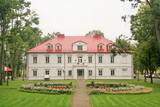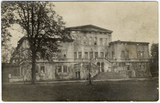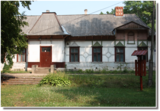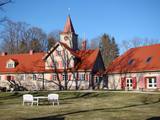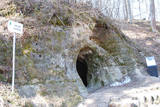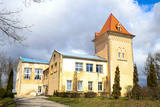| Nr | Nosaukums | Apraksts |
|---|---|---|
|
Kolgas muiža ar savu iespaidīgo teritoriju, daudzajām ēkām un visur jaušamo senatnes elpu neatstās vienaldzīgu! Pirmās ziņas par to ir atrodamas jau no 13. gs, taču mūsdienās redzamo pili cēla baroka stilā 17. – 18. gs., bet 19. gs. 20. gados pārbūvēja klasicisma stilā. Saimniecības ēkas ir celtas g.k. 18. – 19. gs. Laikā no 17. gs. beigām līdz 20. gs. šī bija lielākā Igaunijas muiža. Šobrīd muižas kompleksa ēkās ir iekārtota viesnīca, restorāns, konferenču centrs un muzejs. Interesenti var izmantot vietējo gidu pakalpojumus. |
||
|
Tagad redzamās muižas pils (klasicisma stils) pirmsākumi meklējami 1784. g. Vēlākos laikos to pārbūvēja par divstāvu ēku, kurai ir četru kolonnu portiks tās centrālajā daļā. Jauns pagrieziens muižas attīstībā uzsākās 1993. g., kad uzsākta ēku restaurācija. Šobrīd muižas kompleksā atrodas Grašu bērnu ciemats, bet kungu mājā – viesnīca. |
||
|
Atrodas Gatartas centrā uz reljefa virsmas paaugstinājuma. Muižas pili cēla laikā no 1823. - 1824. g. (fasāde - klasicisma stilā). Tās ieeju vēl pavisam nesen rotāja divi (postīti) lauvu tēli. Par muižas kompleksa varenību liecina vēl 20 citas ēkas (dažādā stāvoklī, g.k. – sliktā!) – ļoti iespaidīgs ledus pagrabs, dārznieka un kalēja māja, klēts, magazīna, alus brūzis, Kundziņkrogs, kas atrodas plašākā teritorijā. Daļēji saglabājies 19. gs. veidotais parks. Drustu muižas īpašnieks – vācbaltietis un pētnieks Ludvigs Kārlis Augusts fon Hāgemeisters (1780. – 1833) 1806. g. organizēja un vadīja Krievijas ekspedīciju uz Aļasku. Šobrīd muižas pils ir privātīpašums un apskatāma no ārpuses. |
||
|
Iespaidīgs, taču ļoti bēdīgā stāvoklī! Cīravas muižas apbūve tapa 18. - 19. gs. un muižas pils - 19. gs. sākumā. Pusgadsimtu vēlāk to pārbūvēja neogotiskā stilā ar simetriskiem tornīšiem un ķieģeļu robojumiem dzegās. Muiža piederēja baronu Manteifeļu – Scēges dzimtai. Pils vestibilā, kāpņu telpā un otrā stāva zālē ir saglabājušies ornamentāli griestu greznojumi, kas tāpat kā pati ēka no iekšpuses nav apskatāmi. Ēkā atrodas arī vērtīgi interjera elementi - 19. gs. sākumā veidots kamīns ar marmora apdari u.c. No pils atsavināšanas brīža (1920. g.) līdz 1951. g. šeit atradās Meža skola (blakus pilij - piemiņas akmens), pēc tam – Cīravas Lauksaimniecības arodvidusskola. Iepretim pilij atrodas klasicisma stilā (ar frontonu un varenām kolonnām) celtais bijušais muižas zirgu stallis (19. gs. sākums), kas šobrīd netiek izmantots un arī apskatāms no ārpuses. Muižas kompleksu ieskauj parks (krietni aizaudzis), kurā ir uzkalniņš – barona suņa kapa vieta. |
||
|
Līdz mūsdienām saglabājušās vairākas muižas ēkas, kas celtas grāfu Plāteru laikā. Muižas vecā pils, kas atrodas Grāfu Plāteru ielas malā - Jāņupītes krastā, celta 1759. gadā (baroks, Venēcijas arhitekts Antonio Parako). Pēcāk to pārbūvēja un pēc jaunās pils uzcelšanas ēkas pirmajā stāvā atradās Plāteru dzimtas vasaras rezidence, bet otrajā un trešajā stāvā bija iekārtota bibliotēka ar ~ 20 tūkstošiem vienību. Bibliotēka, kuras lielākā daļa bija pārvesta uz citiem grāfu īpašumiem, gāja bojā 1. pasaules kara laikā. Krāslavas muižas jaunās pils (Daugavas ielejas krasta augšdaļā) celtniecību uzsāka 1765. gadā (arhitekts Domeniko Parako), sākotnēji baroka, bet 18. – 19. gs. mijā pārbūvējot klasicisma stilā. Ēkā ir atklāti unikāli rokoko stila sienu gleznojumi ar Romas skatiem, kas pēc Polijas piļu analogiem tapuši 18. gs. 60. - 70. gados. Jaunajā pilī līdz 20. gs. 70. gadiem darbojās vidusskola. Tad pils tika “pamesta” un pārvērtās par graustu. Tagad veikti apjomīgi pils fasādes renovācijas darbi, un tā ieguvusi sakoptu veidolu. Pili ieskauj 18. gs. vidū veidots romantiskais ainavu parks – Grāfu Plāteru parks, kas stādīts Daugavas ielejas un to šķērsojošo gravu nogāzēs. Tajā atjaunota mākslīgā grota un lauva – pils sargs, kāpnes to vēsturiskajā vietā, parka celiņi, pagalms. |
||
|
Atrodas Inešu centrā, 5 km uz dienvidiem no Vecpiebalgas. Muižas pirmsākumi meklējami 17. gs. otrajā pusē - 19. gs., kad Orisāres (Orizāre, Arisa) upītes krastos 1786. g. tapusi klasicisma stilā celtā grāfu Šeremetjevu pils. 1905. g. nemieros to nodedzināja, bet četrus gadus vēlāk atkal atjaunoja. Muižas kompleksu ieskauj regulāra plānojuma ainavu parks. Pirms došanās uz šejieni, pārlasām „Mērnieku laikus”, jo Vecpiebalgas muiža kalpojusi par Slātavas muižas prototipu. 1992. g. vīna pagrabā izveidoja Piebalgas novada muzeju. Savukārt muižas pilī darbojas arī Inešu pagasta padome un Porcelāna apgleznošanas studija. Interesanti var doties organizētā ekskursijā pa muižu un tās apkaimi. |
||
|
Atrodas Liepājas ielas – senā Livonijas – Prūsijas ceļa malā. Aizputes simbols, kas attēlots tās ģerbonī un karogā. Aizputes pils celtniecību uzsāka 1248. g. (pastāv dažādas versijas) ordeņmestra Dītriha fon Greningena laikā. To būvēja kā kastelas tipa mūra pili ar stūra torni un koka ēkām pagalmā. Viduslaikos Aizputē atradās Kurzemes bīskapijas centrs. Pēc Livonijas kara 16. gs. otrajā pusē pils vairs netika izmantota, līdz 17. gs. sākumā to atkal atjaunoja, uzceļot piebūves. Ar pārtraukumiem pili apdzīvoja līdz pat pagājušā gadsimta. 70. gadiem, kad tās vienā daļā atradās dzīvokļi. Pilsdrupas ir daļēji iekonservētas, taču kāpelēšana pa tām ir aizliegta un bīstama. Aizpute ir viena no vecākajām Latvijas pilsētām un pirmās ziņas par to ir atrodamas no 1378. gada. 100 m austrumos no pilsdrupām atrodas Akmens tilts pār Tebru - viens no jaunākajiem Latvijā celtajiem mūra tiltiem. Tā akmens margas ir barona Karla fon Manteifeļa dāvinājums (celts 1907. gadā) Aizputei. Tilta ziemeļu puses margās ir iemūrēta granīta plāksne ar Manteifeļu dzimtas ģerboni, kas gan ir vāji izšķirami. |
||
|
Skaista sena parka apjoztā, nesen rekonstruētā, 19.gs. vidu atgādinošā muiža atrodas ziemeļu Lietuvā, 14 km no Paņevežiem. Bistrampolio muižas saimniecība izveidota 19.gs. otrajā pusē – 20.gs. uzbūvētas ēkas: klasicisma stila divstāvu muiža (19.gs. vidus), zirgu staļļi, pagrabi, dārznieku nams, saimniecības ēkas. Muižas saimniecību grezno 19.gs. otrajā pusē iekoptais jauktā tipa parks ar dīķiem. Muižas parkā uz Birtues kalna gozēja ievērojama lapene, blakus dārznieka namiņš. Parka siluetu atdzīvina no jauna bruģētās taciņas un dīķus savienojošie tiltiņi. |
||
|
Cēsu Jaunajā pilī (Pils laukums 9) celta 1777. g. kā Karla Eberharda fon Zīversa dzīvojamā māja, atrodas 1949. g. atklātais Cēsu Vēstures un mākslas muzejs. Ēka ar neogotisko Lademahera torni, kas dekorēts ar smailloka arkādēm un ailām, ir uzskatāma par vienu no pirmajiem Latvijas muižu arhitektūras eklektikas piemēriem. Sākot ar 2012. g. martu, muzejā būs apskatāma mūsdienīga ekspozīcija „Cēsis – Latvijas vēstures simbols", kas interaktīvā veidā iepazīstinās apmeklētājus ar Cēsu un apkārtnes vēsturi no vendu laikiem līdz 20. gs sākumam. Ekspozīcijā būs iekļautas arī sadaļas par Latvijas valsts karoga vēsturi, grāfu Zīversu dzīves gaitām un lielo devumu Cēsu attīstībā. Pils trešais un ceturtais stāvs ir atvēlēts mainīgajām ekspozīcijām, kā arī tajā atrodas īpaša ģimenēm ar bērniem paredzēta istaba. No Jaunās pils Lādemahera torņa paveras vislabākais skats uz Cēsu pilsdrupām, vecpilsētu un Sv. Jāņa luterāņu baznīcu. |
||
|
Muižas ansamblis veidots 19.gadsimtā, tās arhitektūrā atspoguļojās vairāku eklektisma formāli stilistisku virzienu uzslāņojumi, taču dominējošais bija baroka stils. Tā bija grāfa Kazimira Plātera-Zīberga (1808-1876), vēlāk grāfa Fēliksa Konstantina Plātera-Zīberga (1847-1928) rezidence. Pils un daļa saimniecības ēku tika iznīcinātas pirmā pasaules kara laikā, krievu armijas lielkalibra artilērijas apšaudes gaitā. Pārpalikušās drupas laika gaitā tika nojauktas. Līdz mūsdienām saglabājušies vārtu stabi, kas ir apmierinošā tehniskā stāvoklī. Muižā bijusi arī grāfa Zīberga 1697. gadā celta mūra kapela ar altāri un skaistām gleznām. Dievkalpojumus esot noturējis Ilūkstes prāvests. Bijušie īpašnieki: 18. gadsimtā barons A. Plāters-Zībergs, Kazimirs Plāters-Zībergs (1808-1876).
|
||
|
Atrodas Daugavas labajā krastā pie Karikstes upītes ietekas Daugavā. Pili, no kuras mūsdienās ir saglabājusies tikai sienas drupas un pamati, Livonijas ordenis uzcēla 1224. gadā. To apdzīvoja līdz 17. gs. vidum, kad Poļu - zviedru kara laikā celtni sagrāva. Uz pilsdrupām paveras labs skats no ceļa (grantēts), kas aizlokas lejup pa Daugavas ielejas labo krastu. |
||
|
No arhitektoniskā viedokļa Zosnas muiža ir ļoti interesants objekts, jo tās kungu māja ir celta pildrežģa tehnikā, kas ir Latgalē reti sastopams gadījums. Muižas pašreizējā apbūve veidojusies 19. gs. beigās un muižas kungu māja celta 1870. g. historisma stilā pēc kņazu Goļicinu pasūtījuma. Ēkā ir daļēji saglabājies interjers - durvis, griestu rozetes un gaiteņu flīžu segums. 1820. g. celtā kučiera māja ir vecākā muižas kompleksa ēka. Vēl nesen šeit atradās Lūznavas pagasta bibliotēka, bet šobrīd muižas ēkas apskatāmas tikai no ārpuses. Zosnas muižu ieskauj neliels parks, kas stiepjas līdz pat Rāznas ezera krastam, līdz kuram varam nokļūt pa senām akmens kāpnēm un turpināt nelielu pastaigu pa kokiem ieskautu taku. |
||
|
Plateļu dienviddaļā plešas sakoptais Plateļu muižas (muižas vēsture ir zināma, no 16. gs.) parks, kura centrā aug Raganu osis – dižkoks 7,2 m apkārtmērā. Parkā un tā tuvākajā apkārtnē ir redzamas muižas saimniecības ēkas. Vienā no tām – atjaunotajā zirgu stallī ir izveidots muzejs, kurā var apskatīt unikālas 250 vietējo meistaru darinātās maskas. Pašreiz šī ir lielākā šāda veida masku kolekcija Baltijas valstīs. Plateļu ezerā ir atrastas trīs no ozolkoka taisītas vienkoča laivas. Viena no tām (darināta 16. gs.) atrodas Lietuvas Jūras muzejā. Otra (15. gs.) ir apskatāma atjaunotajā Plateļu muižas graudu glabātavas pagrabā (Didžioji gatve 22), jo šobrīd tiek restaurēta. Trešā laiva arī izlikta apskatei kā muzeja eksponāts. |
||
|
Līdz 1724. g. t.s. Cecinas pusmuiža piederēja Hilzenu dzimtai. Kad Hilzena meita Jadviga aprecējās ar Janu Šadurski, kā Malnavas muiža tā dokumentos ir pieminēta 1774. gadā. Vēlāk muiža piederējusi vairākiem īpašniekiem. Muižas galvenā ēka ir celta klasicisma stilā ar barokālām iezīmēm. Pagalma vienā pusē ir klēts, bet tā noslēgumā – kungu nams. 1920. g. agrārās reformas laikā Malnavas muiža bija viena no lielākajām Latvijas muižām, kuras zemju platības aizņēma 12,4 tūkstošus hektāru. Kungu māja postīta Otrā pasaules kara laikā un pēc pārbūves sākotnējā interjeru apdare nav saglabājusies. No saimniecības ēkām saglabājusies 19. gadsimta pirmajā pusē celtā klēts klasicisma stilā, ar diviem četru kolonnu portikiem galvenajā fasādē, kā arī vairākas saimniecības ēkas. Muižas kompleksu papildina parks, kurā vēl joprojām saglabājušies eksotiski krūmi un koki, piemēram, Amūras korķkoki, kā arī divi dzelzsbetona bunkuri, kur īsu brīdi uzturējies Hitlers. Muižas teritorijā atrodas arī Latgales šmakovkas dedzinātava, kur apmeklētājus iepazīstina ar degvīna ražošanas procesu no senatnes līdz mūsdienām. |
||
|
Atrodamas ziņas, ka Rankas muižas pils celta 18. gs. vidū un 19. gs. vidū (nozīmīgi - 1836.-1866.g.) pārbūvēta, kad uzceltas pārējās saimniecības ēkas. 20. gs. šeit atradās dažādas ar izglītību saistītas iestādes: 30. gados - Rankas mājturības skola, pēc 2. pasaules kara - Rankas lauksaimniecības skola. Muižas pils cieta 80. – 90. gadu mijā divu ugunsgrēku laikā. Daļēji saglabājušās kalpu mājas, kūtis, klētis, dārznieka māja, “brūzis” u.c. ēkas. Kopš 2013. gada ieguldīts milzīgs darbs, lai Rankas muižas kompleksu atjaunotu un izveidotu par sakārtotu, tīru vidi. Teritorijā notiek atjaunošanas darbi muižas ēkām. 2003. gadā par Rankas muiža kompleksa īpašniekiem kļuva Ābolu ģimene un, pateicoties viņiem, Rankas muižas komplekss pamazām atdzimst. Ekskursija pa Rankas muižu iekļauj visu telpu apskati: recepciju, antīko automašīnu un priekšmetu izstādi, mākslas galeriju, bibliotēku un Romas katoļu kapelu, kā arī muižas 8,4 hektārus plašo parku ar trīs dīķiem. |
||
|
Helmes ordeņa pilsdrupas slienas stāva paugura galā pie Pērnavas - Valgas lielceļa. Laika gaitā te ir saimniekojuši vācieši, krievi, lietuvieši un zviedri, kas 1658. gadā šo pili arī sagrāva. Pils pakājes gravā tek Arstiallikas (Ārsta avots), kura ūdens palīdzot pret septiņām kaitēm. Pilsdrupu ziemeļu pusē atrodas Helmes alas, kas veco ļaužu valodās ir pazīstamas ar nosaukumu Põrgu(Elle). Apskatīšanai pieejamas divas zāles. Helmes ciemā atrodas novadpētniecības muzejs. |
||
|
Druvienas muižas pirmsākumi ir meklējami 17. gs. beigās. Tagad redzamā apbūve ir veidojusies 19. – 20. gs. Līdz mūsdienām ir saglabājusies muižas pils (1898. g.) un saimniecības ēkas – klētis, kūtis, kalpu mājas. Muižas pilī 20. gs. 50. gados izvietoja pamatskolu. Diemžēl sākotnējie ēkas interjeri nav saglabājušies. Pili ieskauj parks. Šobrīd ēkā atrodas Druvienas Latviskās dzīvesziņas centrs, kas piedāvā dažādas aktivitātes un radošās darbnīcas. |
||
|
Alsungas viduslaiku pils komplekss ir celts pakāpeniski no 14.gs. līdz 18.gs. un ir vairākkārt pārbūvēts. Alsunga kā senais kuršu zemes Bandavas novads minēts jau 1230. g. pāvesta sūtņa līgumā ar kuršiem. 1341. g. Alšvangā (vēsturiskais nosaukums) ir nocietināta māja (ein festes Haus), bet 1372. g. uzsāk mūra pils (četrstūra formas, no akmens) celtniecību, kurā dzīvoja Kuldīgas komturam padotais Livonijas ordeņa firsts. Sākotnēji pils austrumu korpuss tiek izmantots kā dzīvojamās telpas, dienvidu korpuss - saimniecības vajadzībām. Vēlāk 15. – 18. gs. tapa aizsargtorņi un pārējās pils daļas. Pils apjoms (baroka stils) ar diviem torņiem ir ļoti iespaidīgs. Pils ir unikāla Latvijā un ārpus Latvijas ar to, ka tā ir viena no retajām viduslaiku pilīm, kas daļēji saglabājusi savu vēsturisko būvapjoma veidolu. Pilī var apskatīt ekspozīciju par Alsungas pils vēsturi, apskatīt suitu ķēķi, uzrakstīt vēstuli ar spalvaskātu Barbaras buduārā, kā arī romantiskā gaisotnē nosvinēt kādus īpašus svētkus pils apaļajā tornī. 2018. gadā pilī uzsāka restaurācijas darbus un tā ir slēgta. Taču interesenti var brīvi apskatīt to no ārpuses, kā arī iepzīt pils pagalmu. |
||
|
Lodes muižas ēkas izvietojušās t.s. Lodes – Taurenes subglaciālās iegultnes (cauri tek Gauja) austrumu nogāzē. Muižas apbūve tapusi 19. gs. pirmajā pusē, bet kungu māju (klasicisma stils) cēla 1815. g. Pēdējie īpašnieki, kas šeit saimniekoja (līdz 1939. g.) – bija Šmidtu dzimta. Mūsdienās muižas pilī vasarās dzīvo LU Ģeogrāfijas un Zemes zinātņu fakultātes studenti, kuriem šeit ir lauku prakšu norises vieta. Kungu māja apskatāma no ārpuses. |
||
|
Izceļas kā iespaidīga reljefa forma (15 m) Rēzeknes upes labajā krastā. 9. - 12. gs. šeit atradās seno latgaļu pils, kuras vietā 1285. g. Livonijas ordenis uzsāka divstāvu mūra pils celtniecību. Līdz mūsdienām pilskalnā saglabājušās nelielas pils drupas. Pie pilskalna atrodas Austrumlatvijas radošo pakalpojumu centrs - „Zeimuļs” un TIC. |
||

